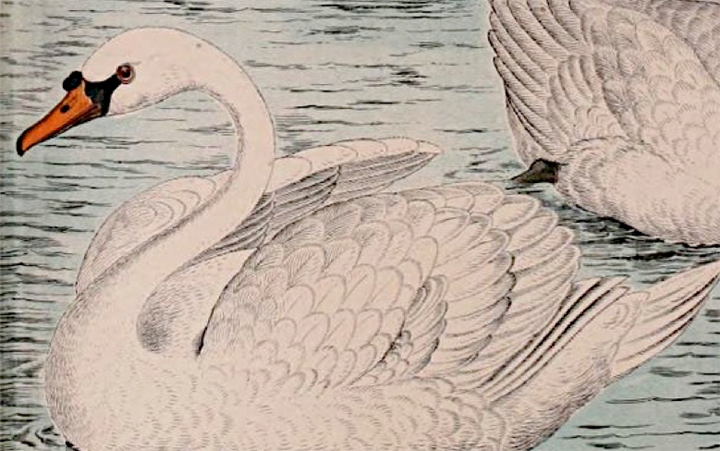The mute swan (Cygnus olor) is a species of swan, and thus a member of the waterfowl family Anatidae. It is native to much of Europe and Asia, and (as a rare winter visitor) the far north of Africa. It is also anintroduced species in North America, Australasia and southern Africa. The name ‘mute’ derives from it being less vocal than other swan species.[2][3][4] Measuring 125 to 170 cm (49 to 67 in) in length, this large swan is wholly white in plumage with an orange bill bordered with black. It is recognisable by its pronounced knob atop the bill.
Adults of this large swan typically range from 140 to 160 cm (55 to 63 in) long, although can range in extreme cases from 125 to 170 cm (49 to 67 in), with a 200 to 240 cm (79 to 94 in) wingspan.[4][12] Males are larger than females and have a larger knob on their bill. On average, this is the second largest waterfowl species after the trumpeter swan, although male mute swans can easily match or even exceed a male trumpeter in mass.[4][13] Among standard measurements of the mute swan, the wing chord measures 53–62.3 cm (20.9–24.5 in), the tarsus is 10–11.8 cm (3.9–4.6 in) and the bill is 6.9–9 cm (2.7–3.5 in).[4]
The mute swan is one of the heaviest flying birds. In several studies from Great Britain, males (known as cobs) were found to average from about 10.6 to 11.87 kg (23.4 to 26.2 lb), with a weight range of 9.2–14.3 kg (20–32 lb) while the slightly smaller females (known aspens) averaged about 8.5 to 9.67 kg (18.7 to 21.3 lb), with a weight range of 7.6–10.6 kg (17–23 lb).[4][14][15][16][17] While the top normal weight for a big cob is roughly 15 kg (33 lb), one unusually big Polish cob weighed almost 23 kg (51 lb) and this counts as the largest weight ever verified for a flying bird, although it has been questioned whether this heavyweight could still take flight.[18]
Young birds, called cygnets, are not the bright white of mature adults, and their bill is dull greyish-black, not orange, for the first year. The down may range from pure white to grey to buff, with grey/buff the most common. The white cygnets have a leucistic gene. All mute swans are white at maturity, though the feathers (particularly on the head and neck) are often stained orange-brown by iron and tannins in the water.[19]
The morph immutabilis (“Polish swan”) has pinkish (not dark grey) legs and dull white cygnets; as with white domestic geese, it is only found in populations with a history of domestication.[20]
(From Wikipedia, March 2015)




